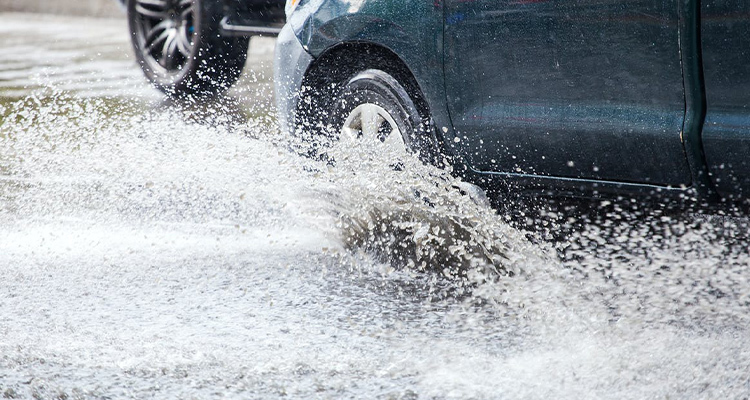
Driving in rainy weather can be quite tricky. You might experience skidding on the wet road and lose control of your car. Even if this happens for a split second, it can lead to a dangerous accident.
Statistics show that most weather-related accidents happen on wet pavement while it is pouring. Approximately 5700 people lose their lives every year and more than 500,000 people are injured due to crashes that happen on wet pavement.
Hence, it is imperative that you take extra care while driving during the rainy season. Wet pavement can lead to hazardous accidents.
In this blog, we will talk about hydroplaning, how to stop and what should be done if your vehicle happens to skid off the road.
What Is Hydroplaning?
Hydroplaning refers to a condition when your vehicles’ tires lose contact with the road and start to skid. This happens when there is a thin layer of water on top of the road and your tires try to roll on top of it.
This type of condition can occur any time a tire can not channel the water fast enough to sustain good contact with the road. This problem does not only occur when there is standing water on the road. It can also cause a driver to lose control of their car during heavy rainfall.
The grooves on tires are designed to offer space for water to go and eject when the tire rolls. When a driver is driving at a safe speed, the tires don’t lose their traction with the asphalt.
However, if the tires on your car are old and their treads have worn out, they will not be able to surpass the hydroplane and develop traction with the road.
How To Avoid Hydroplaning
You have to be very careful while driving in the rainy season. Along with taking care while driving, you have to ensure that your car is in good condition. Some of the things you can do to avoid hydroplaning are:
Avoid Overspeeding
The first thing you have to take care of is the speed of your car. Make sure you are driving 35 mph or slower. At these speeds, the chances of hydroplaning are low since your cars’ tires can get more traction at lower speeds on wet pavement. When you travel at a slower pace you give yourself more time to react to sudden traffic slowdowns, standing water, debris on the road, and disabled cars.
Stopping Distance
In the rainy weather conditions there is a higher chance of your car skidding. Therefore it is best to keep enough stopping distance between you and the next car. As a driver, you have to leave at least 50 to 60 meters of distance between you and the next car.
Don’t Use Cruise Control
Cruise control can cause the car’s tires to spin faster if it hydroplanes. Hence, it is important to avoid cruise control in rainy weather. Go slow and keep the controls in your hand.
Avoid Sudden Acceleration
If you have to speed up, don’t put sudden force on the accelerator. Slowly and gradually increase your speed. Sudden acceleration, as well as sudden deceleration, can result in skidding.
What To Do If You Hydroplane?
Although this might not seem like the right course of action, the only way to gain control over your car if it hydroplanes is by withdrawing your foot from the gas and waiting. Steering or trying to press the brake will prolong the skidding process. Usually while hydroplaning, your car will only skid for a split second before regaining traction.
However, if you are not able to control the car and it goes off-road, don’t worry. You can always call roadside assistance to help come and get you out of the situation.
At
Ontario Towing, we offer reliable and expert roadside assistance services to our customers in Ottawa, Kanata, Orleans, Gloucester, Barrhaven, and surrounding areas.
Contact us today for more information on our services.
Ontario Towing, operating in Ottawa, provides top-notch towing, car lockout, and adept roadside support. With services spanning from mobile tire solutions to long-distance hauls, they remain a cornerstone for assistance in Ottawa and nearby regions.
 Driving in rainy weather can be quite tricky. You might experience skidding on the wet road and lose control of your car. Even if this happens for a split second, it can lead to a dangerous accident.
Statistics show that most weather-related accidents happen on wet pavement while it is pouring. Approximately 5700 people lose their lives every year and more than 500,000 people are injured due to crashes that happen on wet pavement.
Hence, it is imperative that you take extra care while driving during the rainy season. Wet pavement can lead to hazardous accidents.
In this blog, we will talk about hydroplaning, how to stop and what should be done if your vehicle happens to skid off the road.
Driving in rainy weather can be quite tricky. You might experience skidding on the wet road and lose control of your car. Even if this happens for a split second, it can lead to a dangerous accident.
Statistics show that most weather-related accidents happen on wet pavement while it is pouring. Approximately 5700 people lose their lives every year and more than 500,000 people are injured due to crashes that happen on wet pavement.
Hence, it is imperative that you take extra care while driving during the rainy season. Wet pavement can lead to hazardous accidents.
In this blog, we will talk about hydroplaning, how to stop and what should be done if your vehicle happens to skid off the road.